Today's Notables
The Story of Caviar
An Interview with Masaaki Matsui, President and C.E.O. of Matsui Corporation.
May 2004
Hisashi Furuichi
President and C.E.O.
When we started publishing this newsletter, Shinko, in color, we had planned on making the front page for information on customer visits and interviews. Since much of the front page was devoted to the manufacturing of equipment, there were some obstacles such as finding interviewees. Then Mr. Masaaki Matsui of Matsui Corporation with which we have a business relationship, came to TK to give his New Year greeting at the beginning of the year. He brought Japanese produced caviar. Like seeing something delicious for the first time, I first thought "caviar!" and it was even produced in Japan. I was very interested in learning more. Even though there is little correlation to TK business, I thought it was a good idea to learn something from a different industry. I talked our editing staff into making this issue "Today's Notables Special." So we are changing directions slightly with this issue. I visited Mr. Matsui to learn about domestically produced caviar.
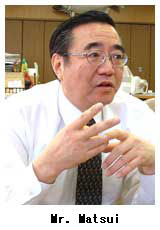
Furuichi :
How did you end up in the caviar business?
Matsui :
I establish Matsui Inc. with the idea of securing sources of protein
for Japanese people so I began R&D and sales of fishing equipment
that would improve the efficiency of the fishing industry. But because
I was apprehensive about the process being too efficient (laugh)
by catching too much fish, I decided to change the emphasis from
supporting catching of fish to supporting developing of fisheries.
At that time, Ishimaki-city in Miyagi Prefecture asked about importing
eggs from the US for fertilization to cultivate silver salmon. That
was around 1983. The fish farming was very successful. At one point,
that company surpassed a major company in importation of eggs for
fertilization to become number one in Japan with level of 23,000,000
eggs. With such good results, a company from Kamaishi-shi in Iwate
Prefecture wondered if I could import juvenile sturgeon. That was
in 1987. That's how I got involved in the caviar business.
Furuichi :
Why sturgeon?
Matsui :
As most people know, caviar is the eggs from a sturgeon. Caviar
is one of the world's three delicacies (Note 1) and is called diamonds
of the sea because of the price at which it is sold. Because of
the tremendous time and effort to raise caviar, you couldn't do
business at a price like for jack fish or sardines that are cheap.
At that time, 100g of caviar was ¥30,000 to the end user because
I had to find a way to get a return on the investment.
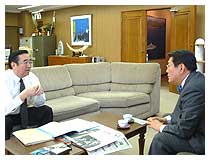
Furuichi :
It's almost like the price of selling cocaine on the streets.
Matsui :
It's not a drug but in Russia, the mafia runs the caviar business.
When Russia was still the Soviet Union, the government controlled it
but after the fall of the Union, but with the mafia only wanting immediate results,
began fishing for caviar very recklessly causing it to become more and more valuable.
Furuichi :
So you mean that it's difficult to raise caviar?
Matsui :
Right. When cultivating silver salmon eggs, you can shorten the period of
that a fish becomes adult from 4 years to 2 years. Therefore, you can get
harvest more volume. Even in Japan, at one point, silver salmon fish farming
was very lucrative but labor became too expensive.
Now silver salmon fish farming has gone to Chile where labor is cheap.
With sturgeon, however, it takes 7 to 8 years for juvenile fish to reach adulthood.
Furuichi :
Wow, almost 8 years!
Matsui :
Yes, but sturgeon live as long as 100 years and 8 of those years to reach adulthood.
Furuichi :
They must be big fish after 100 years.
Matsui :
Right. It depends on the type of course but some sturgeon can grow up to weigh 1 ton.
Currently the fish being farmed in Japan are about 100kg at adulthood.
Furuichi :
Talking about type, since it is called "shark," are there types that might eat people?
Matsui :
Eat people??? (laughing)
I guess sense it is called "chozame" (Note: zame meaning "shark" in Japanese)
there are some people that it is a type of shark because it has a cartilage skeleton
and bony plates called scutes instead of scales. It has it's own order of sturgeon
It is totally different that a shark which is all cartilage.
The sturgeon is a very primitive fish that first appeared 250 million years ago
along with coelacanth.
The shape of the tail and position of the mouth is similar to a shark.
The scales are like bony plates so it became known as "chozame".
Humans appeared on earth 4 million years ago and sturgeon was 250 million years ago.
When you think about it, it's a miracle. Because of the way the sturgeon looks,
it took the part of the name for butterfly "chou" from Japanese.
The English for the fish is "sturgeon" and was used to decorate the dining tables of
courtesians and royalty.
English King Edward II named the sturgeon the royal fish and meat was as precious as the eggs.
Sturgeon do not have teeth like sharks so no matter how big they become,
it would be impossible to bite a human being.
You have probably heard of Osetra and Beluga.
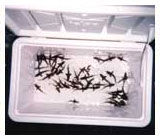
Furuichi :
Right. In the restaurant industry, we call it "blue can" and "yellow can."
It's the type of caviar, right? 50g of Beluga costs about ¥30,000 is commonly known.
Matsui :
That's actually the name of the sturgeon as well.
There's one order, 3 families and 28 species.
The most famous are the types you mentioned earlier, Beluga and Osetra.
Besides those, Sevruga is also fairly well known.
At the time the first company started importing juvenile fish,
the best was an ancestor of the Beluga, the white sturgeon.
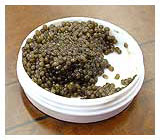
Furuichi :
From what you've said, the caviar you gave me the other day is eggs
from fish that were young 17 years ago?
Matsui :
Actually, starting in 1987, I went to Russia to make some initial observations,
check out products and import channels. It took quite a bit of time.
The caviar I gave you was from a couple of years after that.
It was imported around 12 years ago, just a few years after the initial visit.
The first couple of times did not turn out as I had hoped.
In this picture 1) is a juvenile sturgeon but almost all of them died.
Keeping the young ones alive was a huge challenge.
Then the company decided to import 1,500 from Canada.
From that batch, they still have 110 fish. Even after 10 years,
they continued to feed them and finally have begun to harvest some caviar.
If this industry did not have the flexibility of the third sector, this would not be possible.
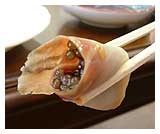
Furuichi :
You are farming fish too, right?
Matsui :
Oh, you must be kidding. I can take things so slowly.
I raised two fish for 2 years as an experiment.
The first year and a half, I kept them in a tank and then to let them grow,
I used a pool on the roof. Then one day, a cat got up there and ate them.
The young fish we import goes to towns and villages like Kamaishi-shi and Ofunato-shi;
private companies like Nippon Steel Corporation and Nissan Construction Co., Ltd.;
fishery unions like Kamaishi Fishery Association, Otsuchimachi Fishery Association
and other third sector businesses like Sunrock Co., Ltd. are the ones that are doing the farming.
They have the blast furnaces and other needed fishery facilities necessary to do farming.
Our business goes only as far as importing juvenile fish.
I am very interested in fish farming so my company is still a member of the Sturgeon Association.
Since there the number of adult fish have increased, we have more of an opportunity to enjoy
caviar and sturgeon meat not to mention doing some menu development.
This has really become more of a hobby of mine.
Furuichi :
That sounds great. Ahhhh....what could be better than tasting caviar?
Matsui :
Hey, I just happen to have caviar and sturgeon meat for that purpose.
It's one of those things that I can talk about all I want but if I don't have you try it,
you might not know what I mean.
Furuichi :
Oh, thank you! Ummmm...I agree,
its one of the world's rare culinary diamonds?these shiny black jewels.
They almost burst in my mouth and the taste fills my whole mouth.
This is absolutely delicious, exquisite. It's really too bad the readers can't taste this as we speak.
The meat is very delicious too. It's smoked to perfection and seems to be a little heartier than salmon.
Ummm....very good. Ta. . Ta...Tasaki san, take it easy eating the caviar......
Thank you Mr. Matsui for a delicious taste of caviar.
(Note 1) Three culinary diamonds: caviar, foie gras, truffles
[Notes following interview]
From the latter half of the 1980s to the beginning of the 1990s, the Japanese economy
grew at an extremely fast rate and became know as the "bubble economy" during which
time many corporations established new ventures that fed the excitement of bring on
new business and expansion. Originally, it was the Plaza Accord in 1985 that triggered
the bubble economy.
At that time, the U.S. was suffering from a huge trade deficit because of the expensive
dollar to yen exchange rate.
With the agreement of the G5 nations, the nations agreed to let the yen float which
led to an immediate depreciation of the dollar to yen exchange rate.
The rate went from ¥240/$1USD to ¥120/$1USD in just a few years. As a result,
Japan had a loss on US treasury bonds and other US dollar assets so many investors
turn to domestic ventures where there was no exchange rate risk.
Financial deregulation was implemented to help the stunned export industries due to
the appreciation of the yen, leading to heating up of speculative investments domestically,
especially in land and stock market. Of course, everyone thought that land prices can only
go up so land prices continued to rise at a dizzying pace.
At that time, one could buy all of the United States for the same price as the 23 boroughs of Tokyo.
Banks used land as collateral for lending more and more.
Because land prices continued to soar, landowners had more worth giving them a sense of
being 'rich' and having deep pockets to further invest in more speculative ventures.
Corporations also tried to expand as much as possible using burgeoning latent assets to
look for lucrative venture business and "get-rich-quick" investments.
The third sector, that didn't have solid business plans or a sense of risk to core competency,
inevitably lost their core business without fail.
Furthermore, this process was accompanied by steady growth of the Japanese economy
which became known as the bubble economy.
When this growth fell off, so did the speculation, leading to a sharp fall in the value of
stock and land assets. Ultimately the bubble burst.
Despite the pessimistic outlook, some speculative ventures did evolve into viable operations.
One is Matsui Co, whom I've interviewed this time.
Matsui started importation of juvenile fish when Sanrokku, a third sector business, started fish farming.
Importing juvenile fish became a viable, strong business precisely because it had a long-term vision
that was not greatly swayed by changes in economic factors and is also what allowed it to grow and develop.
In a time when the development of computers multiples at a pace like dog years to human years,
one becomes acutely aware that this a business that is dealing with fish that have inhabited the earth
250 million years ago and is contributing greatly to the Japanese diet.
Currently Sanrokku is farming over 3,000 sturgeons and it is only a matter of time before domestic
caviar and sturgeon meat become available in the market.
I am very grateful and pleased that we can look forward to such a benefit.
HOME > What’s New > Today's Notables > Details














